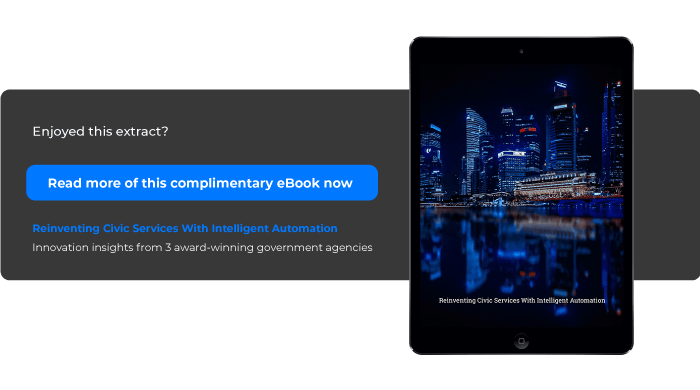This week, we continue our series on Reinventing Civic Services with Intelligent Automation with a look at the factors each of our award-winning government agencies prioritized to ensure winning user experiences for colleagues and citizens alike.
While the long track record of award winning innovations from Douglas County, Albuquerque, and Philadelphia is suitably impressive, it is the way in which all three of these innovation initiatives have been conceived to enhance the service experience for every conceivable stakeholder (both externally and internally) that truly sets these projects apart as examples of transformative
digital governance.
For land and property developers, development approvals in many parts of the country have gone from taking 2-3 months to as long as 10 or 11 months in some of the fastest growing cities in the US (Source). Costs from such delays are doubly punitive for developers: impacting them both directly via increased capital, carrying and interest costs, and indirectly via increased time and labor spent managing complex and manually intensive processes that can vary drastically between jurisdictions.
As a number of recent studies confirm, expediting the land development and review process not only speeds the time to market for entrepreneurial businesses that play a vital role in the economic growth engine, but an expedited development process also fundamentally improves the availability of affordable local housing. With affordable housing projects disproportionally impacted by escalating costs associated with regulatory delays (due to the smaller profit margins of such projects), a protracted development and review cycle inevitably results in fewer affordable housing units being built (Source).
Faced with this challenge, shorter turnaround times for development approvals have now become a key metric for consideration by government leaders keen to address the nationwide issue of affordable housing stocks in their communities.
For innovative jurisdictions like Douglas Country, Albuquerque, and Philadelphia, reducing the turnaround times for development approvals is accomplished through intelligent automation platforms that streamline internal workflows across multiple internal agencies while simultaneously interfacing with developers and citizens in real-time through self-service online portals.
In the Douglas County permitting system for instance, developers are notified via their preferred digital device when they need to submit paperwork or information. Through the portal, they can also access up-to-date status reports to monitor pending decisions which helps them to more accurately schedule pertinent development tasks and milestones.
A formerly manually intensive process that required printing out blueprints, making duplicate copies, signing and sealing documents, pulling permits, and requesting inspections has now been replaced by a transparent and accessible digital workflow where all parties have ready access to the information required to submit plans and applications, communicate updates, notify key stakeholders, and expedite review and approval timelines.
Additionally, in striving to provide open data transparency in the execution of land management workflows, these jurisdictions provide citizens interested in a dialogue on development projects with interactive maps confirming pending projects in neighborhoods of interest.
While undoubtedly a boon to affordable housing advocates, entrepreneurial developers, and engaged citizens alike, the ‘automation of the agency’ is also proving a big win for government staff.
Staff morale and retention are both positively influenced as a result of the reduction and/or outright elimination of time-consuming, redundant, and manually intensive processes. Relationships once fraught with mutual stress and frustration over missed deadlines and inherent inefficiencies improve, as both review staff and developers embrace collaborative digital workflows that greatly
improve communication, transparency and deadline expectations for all involved.
In addition to the direct correlation shown between reduction in review and approval times and a corresponding growth in license and permit revenues, recent studies are also demonstrating the significant impacts of an expedited land development and review process on property tax revenues. In 2016, an economic impact analysis commissioned by the Montgomery County (Maryland) Department of Permitting Services (DPS) indicated that adding a single year to the review process can reduce the value of that property by an average of 20% thus lowering the property tax base (Source). Or, in looking at it from a positive perspective, shortening the time from concept to occupancy by one year could save a developer as much as 20% of the project cost increasing the viability for a range of affordable housing projects.
In addition to new development projects, streamlined permitting and licensing workflows such as those facilitated by POSSE PLS help to return foreclosed properties to productive use more quickly, as well as enabling developers to more rapidly adjust to changing market conditions rather than abandoning plans altogether.